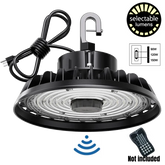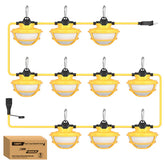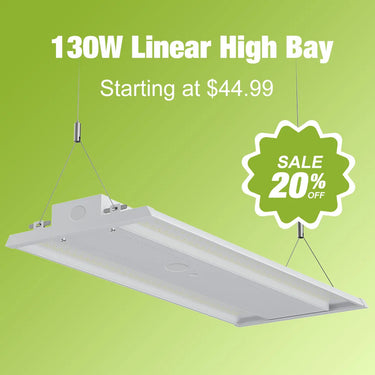High Bay Lighting Comprehensive Guide
High Bay Lighting Comprehensive Guide
Industrial high bay lighting is a critical component of modern industrial illumination. Traditional high bay lights, such as 250W, 400W, 500W, and 1000W metal halide lamps, have significant drawbacks, including 360-degree light emission and substantial energy loss, leading to massive energy waste. Therefore, the development of new-generation LED high bay lights—known for their high efficiency, energy savings, long lifespan, excellent color rendering, and environmental friendliness—holds immense significance for industrial lighting energy conservation.
LED high bay lights have gradually gained popularity due to their directional light emission, low power consumption, excellent driving characteristics, fast response time, high shock resistance, long lifespan, and eco-friendliness. As the most promising alternative to traditional lighting, LED high bay lights are becoming the best choice for energy-saving lighting upgrades in large industrial facilities, marking an inevitable trend in the industry.
Primary Applications of High Bay Lights
High bay lights are widely used in warehouses, factories, gymnasiums, hangars, supermarkets, and other industrial or commercial buildings that require extensive and powerful lighting coverage. Due to high ceilings, these lights must produce high lumen output to ensure uniform and clear illumination on the floor. LED high bay lights are specifically designed for this purpose, offering exceptional brightness, consistent light distribution, and reduced glare, creating a safer and more comfortable environment for workers and visitors.
Key Features of LED High Bay Lights
- Durable Construction: The lamp body is made of high-strength die-cast aluminum with anti-aging electrostatic spray coating, ensuring self-cleaning and strong corrosion resistance.
- High-Quality LEDs: Equipped with top-tier CREE LEDs, these lights offer high stability and a lifespan of 25,000 to 50,000 hours—10 times longer than traditional lighting—delivering low investment and high returns.
- Eco-Friendly Design: As a cold light source, LED high bay lights produce no heat radiation, causing no harm to the eyes or skin. They are free of harmful elements like lead and mercury, making them truly green.
- User-Friendly Design: Easy installation and maintenance make these lights suitable for various applications.
- Efficient Heat Dissipation: The well-designed heat dissipation system keeps the surface temperature low, ensuring safety and reliability.
- Superior Color Rendering: Stable and bright light output ensures accurate color representation. The customizable color temperature meets the needs of different environments.
- Advanced Power Supply: Equipped with Mean Well constant current and voltage drivers, these lights operate within a wide voltage range (AC 90~264V/90~305V), eliminating issues like grid noise pollution caused by traditional ballasts.
- Aesthetic Appeal: With special surface treatment and optional colors, these lights are easy to install and remove, making them suitable for a wide range of applications.
Technical Specifications of YXL Electronic High Bay Lights
- Light Source: CREE high-power LEDs (customizable color temperature)
- Beam Angle: 30-120° (customizable)
- Lifespan: ≥50,000 hours
- Housing Material: Die-cast aluminum
- Cover Material: High-clarity tempered glass
- Dimensions: 300mm×300mm / 560mm×300mm
- Input Voltage: AC100-270V, AC120-347V
- Power: 60W-400W (customizable with built-in power adjustment)
- Temperature Range: -40℃ to +60℃
- Humidity Range: 0-98%
- Protection Rating: IP65
Factors to Consider When Choosing LED High Bay Lights
Selecting the right LED high bay light ensures adequate illumination, energy savings, and safety. Key factors to consider include:
- Lumen Output: Ensure the light output meets the size and purpose of the space. Warehouses, gyms, and production facilities typically require higher lumen levels for clear visibility.
- Power Consumption: Balance wattage and brightness. Modern LED high bay lights deliver high lumen output with low power consumption, reducing electricity costs.
- Color Temperature: Choose between 4000K (neutral white) and 5000K (cool white) for optimal visibility and reduced eye strain in industrial or commercial settings.
- Installation Height: Select lights with appropriate beam angles and intensity based on ceiling height. Higher ceilings require higher wattage and narrower beam angles.
- Energy Efficiency: Look for lights with high lumens-per-watt (lm/W) ratings for better performance and lower electricity bills.
Types of High Bay Lights and Their Ideal Applications
- UFO High Bay Lights: Compact and circular, these lights are ideal for open high-ceiling environments like warehouses, factories, and gyms.
- Linear High Bay Lights: Resembling traditional fluorescent tubes, these lights are perfect for narrow areas like aisles, corridors, and storage racks.
- Damp-Rated High Bay Lights: Designed for humid or dusty environments, these lights are ideal for car washes, food processing plants, and similar settings.
- Hazardous Location and Explosion-Proof High Bay Lights: Certified for use in areas with flammable gases, dust, or chemicals, these lights are suitable for refineries, chemical plants, and grain storage facilities.
- Motion Sensor High Bay Lights: Equipped with motion sensors, these lights save energy by dimming or turning off when no activity is detected, making them ideal for storage areas and warehouses.
- Dimmable High Bay Lights: Allow brightness adjustment based on specific needs, making them suitable for multi-purpose spaces like workshops and arenas.
- High-Voltage 480V Warehouse Lights: Designed for facilities with high-voltage systems, these lights simplify installation in large industrial buildings.
- LED High Bay Lights with Remote Drivers for High-Temperature Areas: Protect sensitive electronics by installing drivers in cooler areas, extending the lifespan of lights in hot environments like foundries and metal workshops.
Cost Analysis of LED High Bay Light Retrofits
While the initial investment in LED high bay lights may be higher, the long-term savings make it a financially sound decision. Key factors include:
- Initial Investment: Costs depend on the size of the facility, the number of lights required, and whether installation is done in-house or by contractors.
- Energy Savings: LED high bay lights can reduce energy consumption by up to 70%, significantly lowering electricity bills.
- Reduced Maintenance: With a lifespan of 50,000+ hours, LED lights require fewer replacements, reducing maintenance costs and downtime.
- Return on Investment (ROI): Most facilities recoup their investment within 1-3 years, with utility rebates further accelerating ROI.
- Long-Term Value: Beyond the payback period, ongoing energy savings and reduced maintenance contribute to improved profitability and sustainability.
LED high bay lights are revolutionizing industrial lighting with their unmatched efficiency, durability, and eco-friendliness. By understanding the key factors and types of LED high bay lights, you can make an informed decision that enhances your facility’s lighting performance, reduces operational costs, and supports long-term sustainability.
Ready to upgrade your lighting? Contact us today for a free consultation and discover how LED high bay lights can transform your space!

















